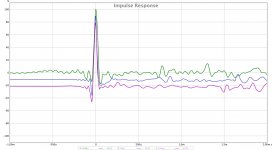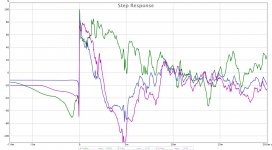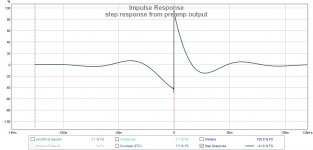Yes I thought so by looking at Thuneau homepage, but I have read about others going out of CPU with small PC's. Maybe to long taps at to low frequencies.
I guess I will just buy a fanless mini PC
FIR can be extrmemely heavy processing depends on the setting. I would recommend to try it with your current fastest computer available at home before buying new one to see how much processing power is acceptable for you.
Recently I tried to download and install Rephase, but while installing I got malware warnings, so I threw it out completely...
Perhaps I got it from the wrong source?
The only "official" source is sourceforge.
Where did you get it from?
I thought sourceforge....The only "official" source is sourceforge.
Where did you get it from?

Hi Pos,
A friend of mine (pda0 on the French forum) and I have written a more extensive RePhase user manual aimed at beginners and we have posted it here: RePhase - Le Tutoriel !
When comparing the impulse generated with RePhase to impulses generated with other 'room correction' systems (Dirac and Trinnov) we have noticed that there is some significant pre-ringing in the RePhase impulse (see attached). Is there any way to limit this pre-ringing ?
Thanks.
A friend of mine (pda0 on the French forum) and I have written a more extensive RePhase user manual aimed at beginners and we have posted it here: RePhase - Le Tutoriel !
When comparing the impulse generated with RePhase to impulses generated with other 'room correction' systems (Dirac and Trinnov) we have noticed that there is some significant pre-ringing in the RePhase impulse (see attached). Is there any way to limit this pre-ringing ?
Thanks.
Attachments
Hi Bear,
Nicely done, I will link it in the sourceforge page
I have been reading some of your experiments on the french forum, you guys are digging it
Regarding preringing, it comes from phase linearization of the low or high pass of the system. If you don't correct them you should not get any preringing (ie purely causal, phase-minimum system).
Not correcting the high pass will avoid low frequency preringing (that mainly shows on the step), while not correcting the low pass will avoid high frequency one (that mainly shows on the impulse).
Linearizing the phase of the high pass (BR, sealed, etc.) is a matter of taste, but in practice you never wants to correct the low pass as it will cause visible (audible?) preringing for no audible (visible?) benefit.
A wrong centering of the impulse might result in unwanted correction of the low pass: you want to get the polarity right and center of the first peak as a first approximation to get a phase that asymptotically reach 0° at Nyquist. You might then need to slightly adjust the time offset within rephase (or in the measurement software) in order to get something that looks correct (eg if the level drop in the UHF phase info is probably not usable there, and you want to rely on the phase behavior of the HF to assert that asymptotic behavior).
Then while you start applying filter linearization (first thing to do before touching phase EQ) you might need to adjust time offset further, always with that asymptotical target in mind).
Doing so you in fact make the phase behavior of the low pass "disappear", but it is obviously still there and you can get it back by playing with the time offset to get a causal impulse.
Also note that low pass pre ringing can also come from the antialiasing linear-phase filter of the DAC.
Hope this all makes sense
Nicely done, I will link it in the sourceforge page
I have been reading some of your experiments on the french forum, you guys are digging it
Regarding preringing, it comes from phase linearization of the low or high pass of the system. If you don't correct them you should not get any preringing (ie purely causal, phase-minimum system).
Not correcting the high pass will avoid low frequency preringing (that mainly shows on the step), while not correcting the low pass will avoid high frequency one (that mainly shows on the impulse).
Linearizing the phase of the high pass (BR, sealed, etc.) is a matter of taste, but in practice you never wants to correct the low pass as it will cause visible (audible?) preringing for no audible (visible?) benefit.
A wrong centering of the impulse might result in unwanted correction of the low pass: you want to get the polarity right and center of the first peak as a first approximation to get a phase that asymptotically reach 0° at Nyquist. You might then need to slightly adjust the time offset within rephase (or in the measurement software) in order to get something that looks correct (eg if the level drop in the UHF phase info is probably not usable there, and you want to rely on the phase behavior of the HF to assert that asymptotic behavior).
Then while you start applying filter linearization (first thing to do before touching phase EQ) you might need to adjust time offset further, always with that asymptotical target in mind).
Doing so you in fact make the phase behavior of the low pass "disappear", but it is obviously still there and you can get it back by playing with the time offset to get a causal impulse.
Also note that low pass pre ringing can also come from the antialiasing linear-phase filter of the DAC.
Hope this all makes sense
Hi Pos,
A friend of mine (pda0 on the French forum) and I have written a more extensive RePhase user manual aimed at beginners and we have posted it here: RePhase - Le Tutoriel !
When comparing the impulse generated with RePhase to impulses generated with other 'room correction' systems (Dirac and Trinnov) we have noticed that there is some significant pre-ringing in the RePhase impulse (see attached). Is there any way to limit this pre-ringing ?
Thanks.
Hi Bear,
Could you please explain what are those impulse responses obtained from?.
System configurations / crossovers / on/off axis etc...?
Best Regards,
Bohdan
Hi Bear,
Hope this all makes sense
Hi Pos,
Thanks for your answer. A lot of information to digest and experiments to conduct before I can make my mind and answer whether this makes sense for me
Thanks again.
Hi Bear,
Could you please explain what are those impulse responses obtained from?.
System configurations / crossovers / on/off axis etc...?
Best Regards,
Bohdan
Hi Bohdan,
These impulses are obtained in a 'room correction' mode.
System is Mac -> Mutec -> DAC (Devialet).
Measures have been made in listening position (off axis).
Hope this helps.
Hi Bohdan,
These impulses are obtained in a 'room correction' mode.
System is Mac -> Mutec -> DAC (Devialet).
Measures have been made in listening position (off axis).
Hope this helps.
Hi Bear,
Sorry, still not clear.
Are you saying, that you have attempted to perform room equalization (room is typically non-minimum phase) using minimum-phase equalization?.
Was the room equalization attempted above Schroeder frequency?.
Best Regards,
Bohdan
Hi Bear,
Sorry, still not clear.
Are you saying, that you have attempted to perform room equalization (room is typically non-minimum phase) using minimum-phase equalization?.
Was the room equalization attempted above Schroeder frequency?.
Best Regards,
Bohdan
You question becomes too technical for me I guess. Sorry I cannot answer it. Just starting
Hi everyone,
To complement the question of SwissBear, please see the attached STEP response as measured with REW for Dirac, Trinnov and RePhase on the same system and similar corrections implemented.
The result on amplitude vs frequency and impulse responses are extremely close to Dirac and Trinnov (actually they may even look better), however the STEP response shows a very significant pre-ringing compared to Dirac and Trinnov.
When listening to the system, I keep finding the result of both Dirac and Trinnov better (although the improvement vs no correction is excellent) and I wonder whether this pre-ringing could be a potential cause of this difference.
Is there a way to reduce it by selecting better parameters inside RePhase ?
Many thanks in advance for your help.
To complement the question of SwissBear, please see the attached STEP response as measured with REW for Dirac, Trinnov and RePhase on the same system and similar corrections implemented.
The result on amplitude vs frequency and impulse responses are extremely close to Dirac and Trinnov (actually they may even look better), however the STEP response shows a very significant pre-ringing compared to Dirac and Trinnov.
When listening to the system, I keep finding the result of both Dirac and Trinnov better (although the improvement vs no correction is excellent) and I wonder whether this pre-ringing could be a potential cause of this difference.
Is there a way to reduce it by selecting better parameters inside RePhase ?
Many thanks in advance for your help.
An externally hosted image should be here but it was not working when we last tested it.
Hi Bear,
Sorry, still not clear.
Are you saying, that you have attempted to perform room equalization (room is typically non-minimum phase) using minimum-phase equalization?.
Was the room equalization attempted above Schroeder frequency?.
Best Regards,
Bohdan
Hi Bohdan, actually we have experimented with RePhase, Trinnov and Dirac quite a lot and probably beyond reason
RePhase allows to perform room correction without any limit but the results sometimes end-up being strange as well
The Schroeder frequency in my room is around 160Hz. Does it mean that making any phase linearization below that frequency is doomed to fail (or to yield unpredictable results) ?
Sorry if the question is stupid, but we are using RePhase as amateurs without any specific knowledge and we are learning by making many mistakes
Thanks.
Hi pda0,The Schroeder frequency in my room is around 160Hz. Does it mean that making any phase linearization below that frequency is doomed to fail (or to yield unpredictable results) ?
rePhase is aimed at correcting only the source, ie the speaker in anechoic situation, using a combination of gated and close mic measurements, as well as theoretical data.
If the loudspeaker is well behaved and the room is symmetrical you should not need any further EQ above the Schroeder frequency, or only maybe some very gentle low Q EQ to tailor the HF balance, etc.
Under Schroeder is another story, and can be addressed using rePhase as a second layer after the "source EQ", using multiple or averaged measurements such as MMM.
Hi pda0,
rePhase is aimed at correcting only the source, ie the speaker in anechoic situation, using a combination of gated and close mic measurements, as well as theoretical data.
If the loudspeaker is well behaved and the room is symmetrical you should not need any further EQ above the Schroeder frequency, or only maybe some very gentle low Q EQ to tailor the HF balance, etc.
Under Schroeder is another story, and can be addressed using rePhase as a second layer after the "source EQ", using multiple or averaged measurements such as MMM.
Thanks. Actually, I am just experimenting to see whether it is possible to replicate what Trinnov and Dirac do in my environment.
Since I have both a Trinnov and Dirac, I have been able to measure (with REW) various setups in my room, and have been able to get Dirac perform the same job as Trinnov (quite successfully actually and the listening result is amazingly close).
Since Bear started exprimenting with RePhase, we have tried to make it work, so that it provides a "free" room correction for those who can't afford a Trinnov or even a Dirac licence.
From a measurement standpoint (again with REW and its limitations), it is quite easy to get similar results with RePhase than with both Dirac and Trinnov, and when listening to the result, it is quite an improvement already.
In my room, I have not applied any EQ above 100Hz (actually the highest is at 85Hz) since most problems are mode related and can be dealt quite handily with RePhase.
For the phase part, although I trust that REW with a cheap UMIK-1 mike can only provide incorrect information in the high frequencies in particular, using the Trinnov outputs as a "reference" has made it possible to consistently measure the same phase than what Trinnov provides, so I have been working from there.
And by playing with RePhase, it has been possible to also replicate the phase corrections applied by both Trinnov and Dirac (as the measurements show).
But, this implied the pre-ringing effect mentionned above, which may (or may not) play a role in the non-satisfactory listening result.
I will have a look into the MMM link you provided, and will also try to understand what your recommendations on minimizing the pre-ringing actually mean in terms of what corrections should be avoided.
Currently, I am correcting first the phase (by entering the crossover characteristics of my speakers : Vivid Audio Giya G3 (24dB/octave at 220Hz, 880Hz and 3500Hz + bassreflex at 30Hz or so, and adjusting with the phase EQ what is left to adjust) from a REW measurement gated so that the phase measurement correlates with what Trinnov provides (actually this is achieved through a frequency depending windowing at 1/3 octave).
Once the phase is corrected, I am using the amplitude EQ to reduce the modes wherever needed while keeping the phase linear.
With this procedure, I end-up having the pre-ringing as shown, but actually although I haven't tried many alternate scenario, all the trials I did so far generated this pre-ringing...
If you have any hint on the matter, it would be very much appreciated
I recently realized that some people here mixed up the anechoic response with room response, and ended up accusing DSP correction...
Appears to be so.
Hi everyone,
To complement the question of SwissBear, please see the attached STEP response as measured with REW for Dirac, Trinnov and RePhase on the same system and similar corrections implemented.
The result on amplitude vs frequency and impulse responses are extremely close to Dirac and Trinnov (actually they may even look better), however the STEP response shows a very significant pre-ringing compared to Dirac and Trinnov.
When listening to the system, I keep finding the result of both Dirac and Trinnov better (although the improvement vs no correction is excellent) and I wonder whether this pre-ringing could be a potential cause of this difference.
Is there a way to reduce it by selecting better parameters inside RePhase ?
Many thanks in advance for your help.
An externally hosted image should be here but it was not working when we last tested it.
hi,technically rephase has the step response thats closest to an actual "flat" response as measured straight out of the preamp
Attachments
If magnitude and phase curves are identical, impulses should also be.And by playing with RePhase, it has been possible to also replicate the phase corrections applied by both Trinnov and Dirac (as the measurements show).
In your situation the phase might be flat in both cases, but measurement impulse centering might be different, causing unwanted corrections up top, and in fact a different phase curve.
This appear to be the case here: RePhase - Le Tutoriel !
The phase goes up to around 180° at Nyquist, and you trying to linearize it using phase EQ will cause preringing, as explained above.
Here you should play with the time offset setting to get something that reaches 0° at Nyquist.
Currently, I am correcting first the phase (by entering the crossover characteristics of my speakers : Vivid Audio Giya G3 (24dB/octave at 220Hz, 880Hz and 3500Hz + bassreflex at 30Hz or so, and adjusting with the phase EQ what is left to adjust) from a REW measurement gated so that the phase measurement correlates with what Trinnov provides (actually this is achieved through a frequency depending windowing at 1/3 octave).
Once the phase is corrected, I am using the amplitude EQ to reduce the modes wherever needed while keeping the phase linear.
Phase EQ is the problem here.
Here is something you can try:
- play with polarity and time shift setting to get a ~0° phase up top.
(polarity looks to be good in your measurement)
- At this point you should have a phase behavior that corresponds to your crossover and speaker characteristics.
- use filter linearization to address crossover and BR.
- readjust time offset if needed
- do not use phase EQ right now
- use minimum-phase EQ to flatten magnitude and phase at the same time while staying true to the minimum-phase relation.
- readjust time offset if needed
- use *gentle* phase EQ to address remaining phase deviations
- if you want to avoid LF preringing remove the BR linearization setting, to get a fully minimum-phase system
- Home
- Design & Build
- Software Tools
- rePhase, a loudspeaker phase linearization, EQ and FIR filtering tool


